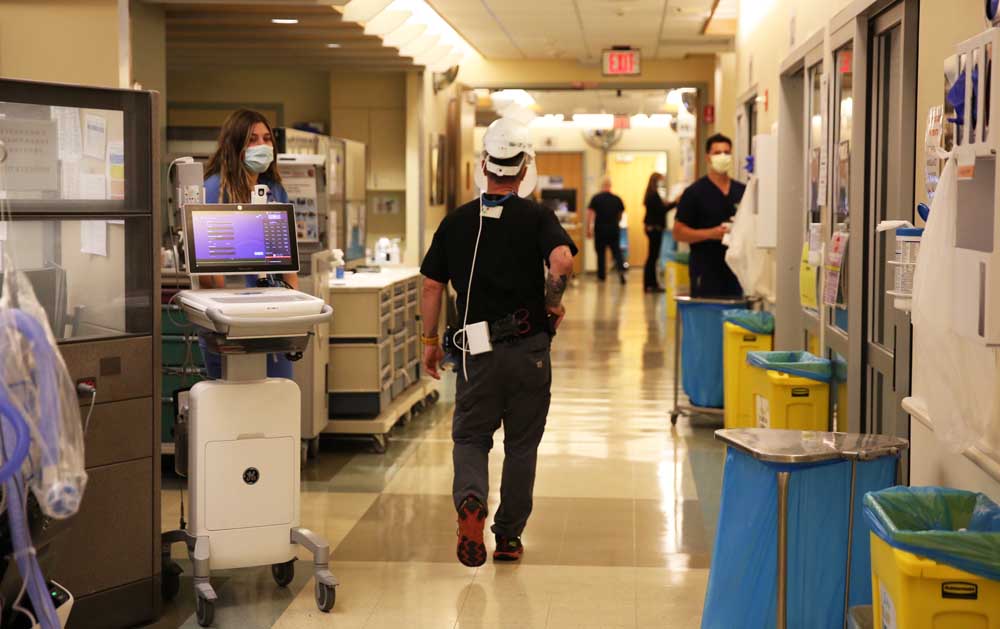Biggest but least lethal COVID-19 wave of pandemic will hit Oregon by January
Published 2:15 pm Friday, December 17, 2021

- Emergency personnel care for patients at St. Charles Bend in 2021.
St. Charles Bend is gearing up for the new omicron variant of COVID-19 that is expected to sweep into Oregon over the next two to four weeks, setting new records for infections and filling hospitals beyond capacity.
The sixth wave of new infections comes as Oregon was slowly recovering from the delta surge that began in July and peaked in early September.
A forecast released by the Oregon Health & Science University said the new variant will push out the current dominant delta virus by the last week of December.
“While we got very encouraging news that the state is going to extend its staffing contract with nurse travelers, we’re urgently imploring people to get vaccinated, and if they’re eligible, to get boosted,” said Dr. Jeff Absalon, St. Charles Health System chief physician executive. “It is the single most important step we can take to mitigate the impact of the wave we know is coming.”
Peter Graven, the lead author of the OHSU forecast, said omicron doubles at twice the rate of the current delta variant, doubling the number of infections every two days.
“We have about two to three weeks before we’ll see omicron accelerate and become the dominant strain,” Graven said. “We expect that cases will ramp up quickly.”
The OHSU report said early studies in Europe show current vaccines and earlier exposure to the virus are not as effective against omicron as earlier variations of COVID-19.
The Pfizer and Moderna two-shot vaccination loses about 50% of its protective power with omicron. The third booster shot of Pfizer or Moderna vaccine, now authorized for anyone over age 16, offered significant additional protection.
The booster is especially needed for those most vulnerable to severe illness, including immunocompromised residents or older adults living in congregant settings.
“We’re in a race against the clock,” Gov. Kate Brown said during a Friday afternoon press call. “I’m calling on 1 million Oregonians to step up and get a booster shot.”
Hospitalizations could top 2,000 per day, swamping the state health care system at a time when other states are dealing with the same crisis and will be unable to lend assistance to Oregon.
Graven said the number of infections will be somewhat mitigated by the expectation of lower severity of each case. Hospital stays will be shorter, and each case is less likely to require an intensive care unit bed or ventilator.
“The good news is I am not expecting a lot of deaths from this variant,” Graven said.
Dr. Renee Edwards, chief medical officer of OHSU, said the ability of omicron to infect vaccinated people means that doctors, nurses and others who care for the sick can get sick themselves, further depleting the ranks of available staff.
“We’re only halfway down” the peak of the delta surge that began last summer, she said.
Brown said the state would move to field at least three more major vaccination centers and to rush new anti-viral medicines to hospitals in preparation for the surge. The state is attempting to contract for more out-of-state medical personnel and is working with the Biden administration on federal help.
No additional restrictions or mask mandates are in the mix for now, Brown said, but “all tools are on the table.” She said with the availability of vaccines, masks and medicines, the situation this year is different from last year.
Brown said she was taking the step of immediately freezing plans to bring state workers back into offices on Jan. 1.
COVID-19 infections have been on the rise again even before omicron cases were first reported on Monday.
The delta variant has been showing increased presence in Oregon, as well as the rest of the nation, as cold weather keeps people indoors, and larger holiday gatherings have made it easier for the virus to spread.
OHA’s weekly report on COVID-19 cases found that unvaccinated people accounted for just under 70% of new infections.
Vaccinated people accounted for just over 30%.
The average age of the breakthrough cases during that period was 44.
As of Wednesday, Oregon has reported 49,250 COVID-19 vaccine breakthrough cases, with all 36 counties having reported the infections of vaccinated people.
The biggest difference is in severity of illness. Only 4.4% of all vaccine breakthrough cases have required hospitalization, and 1.3% have died. The average age of vaccinated people who died was 81.








